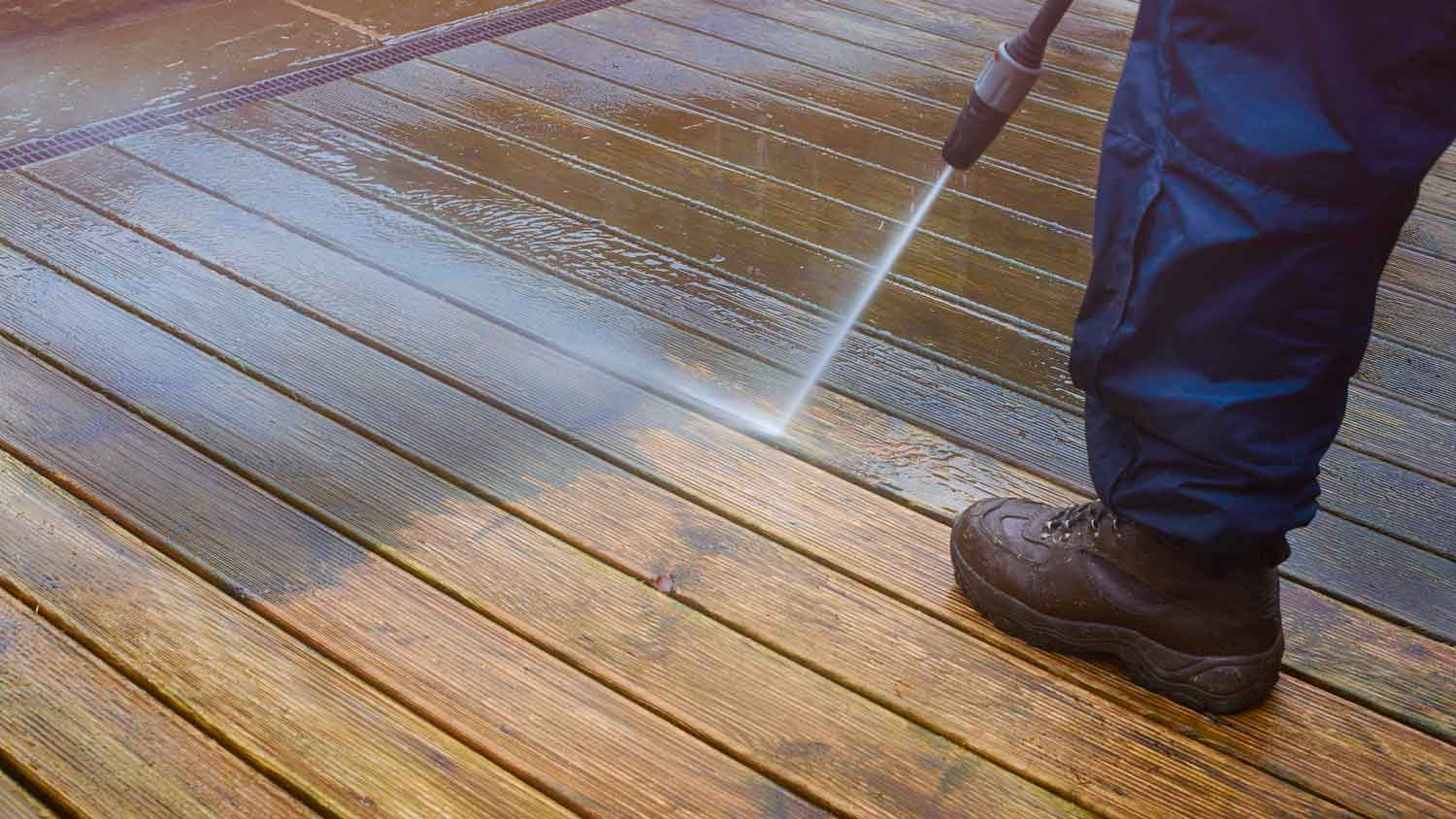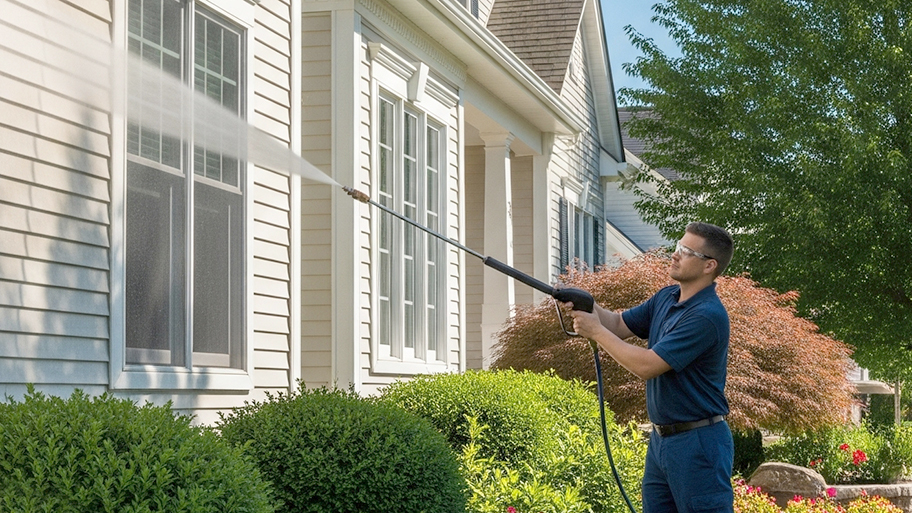
The cost to pressure wash a deck depends on its size, condition, material, and whether you DIY the job. Help set your budget with this cost guide.
Pressure washers make deck cleaning quick and easy, but you’ll need to be careful


A pressure washer is one of the most straightforward, effective tools for deep cleaning a deck. You can remove dirt, mildew, and old stains or paint from any wooden deck boards in one day. However, it's vital to learn how to pressure wash a deck properly to avoid accidentally damaging the natural wood surface. If your deck is ready for a refresh, follow this guide to do it safely.
Be prepared to discuss your home size, number of floors, and home layout with your pro.
Mention what materials you have on or around your home that you want pressure washed.
Ask your pro if they use cleaners and ensure they’re safe for use around plants and pets, if applicable.
Discuss any add-on services you want, like soft washing for your roof, concrete sealing, or gutter cleaning.

Pressure washer spray is strong enough to cause small rocks to go flying, and the spray can cause injuries if it hits you or someone else directly. Take the following precautions for protection:
Wear protective clothing that covers your skin and eyes.
Have family members and pets keep their distance while you work.
Practice spraying with the wand before aiming it at anything to get the hang of it.
Cover shrubs, gardens, and air conditioning units with a plastic drop cloth.
Remove the drop cloth as soon as you're done washing to avoid harming plants.
Keep all electrical outlets covered.
If you plan to buy or rent a pressure washer, be sure not to mistakenly purchase a power washer instead. Power washers incorporate a heating element to produce highly pressurized steam. Pressure washers have no heating element and simply pressurize cold tap water, which is gentler on natural wood decking.
We do not recommend pressure washing a deck made from composite material. Composite decking is softer than natural wood and can be damaged by high pressure more easily. The damaged material is then open to chipping, sun damage, and hard-to-remove mold stains.
In most cases, you should simply use a garden hose, scrub brush, and gentle soap on your composite deck. This can also help you keep the cost to wash your patio or deck lower. If you still prefer to pressure wash, keep the pressure as low as possible and maintain a further distance of at least eight inches between the nozzle tip and the deck surface.
Even someone who has done a fair amount of pressure washing should remember that the settings required for a deck are very different compared to cleaning gutters with a pressure washer. When you pick up a standard pressure washer, it will come with a set of universal nozzles. Nozzles with degree markings determine the spray pattern. Soap nozzles are responsible for creating suds. There are also turbo nozzles that create rapid spinning motions. However, not all nozzles are safe for decks. Too much pressure can strip wood.
Typically, a deck needs a 25-degree nozzle to a 40-degree nozzle. A higher degree equals less pressure. Here's a guide to the right and wrong nozzles when pressure washing a deck:
Red 0° Nozzle: Intended for soffits and other high areas that require extra pressure. Avoid using it on wood or painted surfaces.
Yellow 15° Nozzle: Can be used on PVC materials. Avoid on wood and painted surfaces.
Green 25° Nozzle: Safe for decks as long as you keep a large enough distance to avoid damaging paint or wood finish.
White 40° Nozzle: The wider spray and lower pressure on this nozzle make it generally safe for decks.
Turbo Nozzle: Avoid on decks.
Soap Nozzle: Generally safe for decks.
Connect your pressure washer to the hose and turn it on at the lowest power setting. Test your water pressure by pulling the trigger on an inconspicuous part of the deck, such as a stair tread or far corner. Adjust your distance and angle until your pressure washer successfully removes dirt without damaging the deck or splashing back at you.
Follow this optional step if your deck is dark or stained due to mildew. A deck cleaning solution that includes oxalic acid will brighten the boards without harming them. Some solutions come pre-mixed, while others need to be diluted with water. Follow the instructions on the package before pouring the solution into the pressure washer's soap dispenser.
Use long, broad strokes to apply just enough solution to thoroughly wet the wood. Be sure to reach all corners, cracks, and crevices. Allow the cleaner to sit for about 20 minutes or according to the manufacturer's instructions.

Start by washing the deck railings, then move to the boards. Work from your house outward, following the wood grain with wide, horizontal sweeps. Go back and forth, tackling one row of boards at a time and overlapping each area slightly to avoid visible cleaning edges.
The water pressure will do most of the work, so your main job is to control the pressure and aim. Do so by sweeping your arm laterally and maintaining a six-inch distance from the nozzle tip to the boards.
Once you've finished, you may decide that your deck requires multiple applications of cleaning solution or multiple passes with the pressure washer. Repeat steps two and three as needed.
After pressure washing, let your deck dry for two full days after pressure washing to prevent bending or warping the wood.
Once dry, you may wish to spot-sand your deck surface with rough sandpaper to remove splinters or rough areas that may have formed due to the moisture. However, if you plan on refinishing your deck, you'll need to use an orbital sander to sand the entire surface.
If you already own a pressure washer, your only expense will be the cleaning solution. You can purchase a pressure washer for $250 on average or rent one for $35 to $175 per day.
If you don't want to risk damaging your deck, you can hire a professional power washing service near you to wash your deck. If you’re having a pro come to your home, you may wish to inquire about the cost to pressure wash a fence or other cleaning projects around your home’s exterior so you can get the most bang for your buck.
From average costs to expert advice, get all the answers you need to get your job done.

The cost to pressure wash a deck depends on its size, condition, material, and whether you DIY the job. Help set your budget with this cost guide.

Need to breathe new life into your dirty siding and trim? Explore the cost to pressure wash a house to boost your curb appeal instantly.

Pressure washing your fence can restore its appearance and keep your home looking great. Learn how much it costs based on factors like square footage and material.

What is pressure washing? It’s a quick way to get rid of built-up stains—but only under the right circumstances. Here’s when (and when not) to pressure wash.

Find the root cause for why your pressure washer is not building pressure and how to fix it. You can resolve simple issues in minutes.

What is power washing? It’s the act of washing a surface with hot, high-pressure water. Here’s how to know when power washing is right for your home.